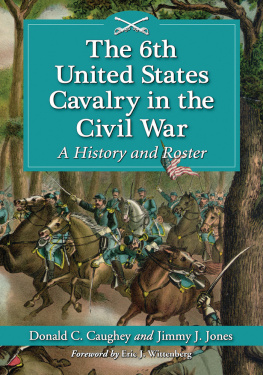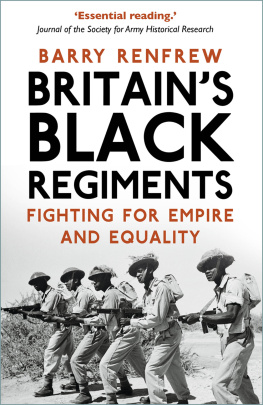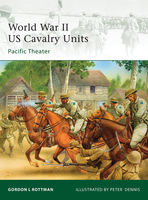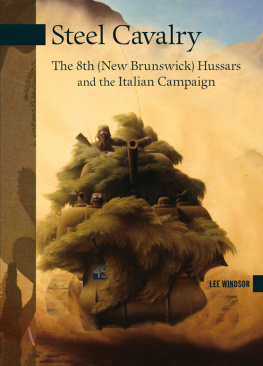
The 6th United States Cavalry in the Civil War
A History and Roster
DONALD C. CAUGHEY and JIMMY J. JONES
Foreword by Eric J. Wittenberg

McFarland & Company, Inc., Publishers
Jefferson, North Carolina, and London
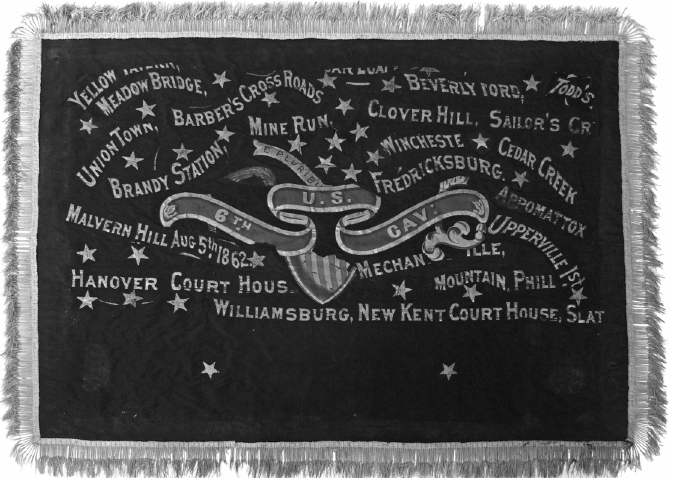
Frontispiece: Regimental colors, 6th U.S. Cavalry (courtesy of the U.S. Cavalry Museum, Ft. Riley, Kansas).
LIBRARY OF CONGRESS CATALOGUING DATA ARE AVAILABLE
BRITISH LIBRARY CATALOGUING DATA ARE AVAILABLE
e-ISBN: 978-1-4766-0083-3
2013 Donald C. Caughey and Jimmy J. Jones. All rights reserved
No part of this book may be reproduced or transmitted in any form or by any means, electronic or mechanical, including photocopying or recording, or by any information storage and retrieval system, without permission in writing from the publisher.
On the cover: print entitled Battle of the WildernessDesperate fight on the Orange C.H. Plank Road, near Todd's Tavern, May 6th, 1864, Kurz & Allison,1887 (LIBRARY OF CONGRESS); United States Cavalry emblem
McFarland & Company, Inc., Publishers
Box 611, Jefferson, North Carolina 28640
www.mcfarlandpub.com
This book is respectfully dedicated to the brave troopers of the 6th U.S. Cavalry who have answered the nations call and followed the guidon in every conict since its inception. And to those brave men and women who continue to serve in the regiments active squadrons today, at home and abroad.
Acknowledgments
The interpretations set forth in this book are our own, and we accept full responsibility for them. If there are errors in the telling the story of the regiment, they are ours and we ask the readers indulgence.
A work such as this would not be possible without help from others. We were consistently thrilled and amazed at the assistance we received from complete strangers throughout the project. We have a number of people to thank for their support, and we hope we havent missed anyone. If we have, please understand that it was simply through oversight and not a lack of appreciation for your assistance.
Cavalry historian Eric Wittenberg has been of invaluable assistance as friend and mentor throughout the books formation. Indeed, it may not have reached publication without him.
Blake Magner drew the majority of the maps for this book before his untimely passing in October 2011. An experienced cartographer, he was grufy patient in dealing with rookie authors whose notes and sketches were not always legible. We feel that the classic look of his maps will greatly enhance the readers understanding of the regiments many long marches and campaigns. Thank you, Blake: you are missed.
Steven Stanley was kind enough to step in on very short notice and provide the battle maps for the Beverly Ford and Faireld chapters. A consummate professional, he expanded both of our original maps into sequences which will make it much easier for the reader to follow these confusing engagements.
Researcher Karen Higgins, for assistance in obtaining material from the L. Henry Carpenter Papers at the Historical Society of Pennsylvania, as well as the staff of the society for their assistance. This huge collection of letters was invaluable to our record of the regiment.
Our thanks also go to the following:
Patty Millich, descendant of one of the regiments soldiers, for countless hours spent locating obscure soldier enlistment records and transcribing sections of the L. Henry Carpenter letters.
The staff of the U.S. Cavalry Museum, Fort Riley, Kansas, who not only provided access to a set of the regiments actual Civil War colors, but also provided the photo of them included in this book.
Cavalry historian J.D. Petruzzi, for several rare pieces of information and numerous helpful comments throughout the process.
Conrad Bush, for permitting use of material from his previously unknown collection of the letters and newspaper articles of B. Nathaniel Owen. We look forward to seeing them in print on their own someday soon.
Bev Applegate at the Beaver County Historical Society, for bringing the Robert Steel letters to our attention, and descendant Alta Musgrave, for permission to use them in this book.
Alice Gayley, for assistance in obtaining material from the National Archives, and Lori Dodson, for her assistance in obtaining material from the LIBRARY OF CONGRESS.
Finally, we express our appreciation and devotion to our wives, Gina Caughey and Twyla Jones. Theyve invested as much in this book as we have, including too much lost time with our families, mountains of books and paper clutter, hours of animated discussion about people long dead, and countless weekend and evening hours in front of a computer researching and writing. We could not have done this without them.
Foreword by Eric J. Wittenberg
While there have been thousands of books published on the American Civil War, few of them have dealt with the service of the small core of professional soldiers who made up the regular army. Nearly all tell the story of the Regular Army infantry and artillery regiments without telling the story of the Regular horse soldiers. This book begins to address that notable decit.
When the war broke out in the spring of 1861, the regular army numbered only about 16,000 men serving in ten regiments of infantry, four regiments of artillery, two regiments of cavalry, two regiments of dragoons, and one regiment of mounted infantry. The strength and combat readiness of these Regular Army units decreased dramatically when Southern ofcers resigned to serve their states and other noncommissioned and commissioned ofcers resigned in order to accept commissions as ofcers in Union volunteer regiments, thereby leaving a drastic shortage of men to ll the ranks. Consequently, President Abraham Lincoln put out a call for 75,000 volunteers after the fall of Fort Sumter.
After the outbreak of hostilities, the Union high command decided that it needed a third regiment of cavalry, which was raised in western Pennsylvania and eastern Ohio. Originally designated as the 3rd U.S. Cavalry, its name changed shortly after its organization when all regular army mounted units, whether cavalry, dragoons, or mounted infantry, were redesignated as cavalry. These units were then numbered in accordance with their age. The oldest units (the 1st and 2nd Dragoons) received the lowest numbers. As the newest unit, the new cavalry regiment was redesignated as the 6th U.S. Cavalry, a designation the unit carries to this day.
The study of cavalry operations has always been a niche area of scholarship, but it is the one I have always found most interesting. The scarcest regimental studies are those dealing with the U.S. Armys regular cavalry regiments. Until the publication of this book, there was no monograph dedicated to the study of the operations of the regular army cavalry units in the Civil War. While the 2nd, 5th, and 6th U.S. Cavalry regiments have unit histories, they are just that: unit histories that cover the entire career of the regiments that are their subjects up to the date of their publication. These books certainly contain coverage of the Civil War, but the Civil War makes up only a portion of these books, and they largely lack detail. The 1st, 3rd, and 4th U.S. Cavalry regiments do not have published unit histories at all.
Next page
